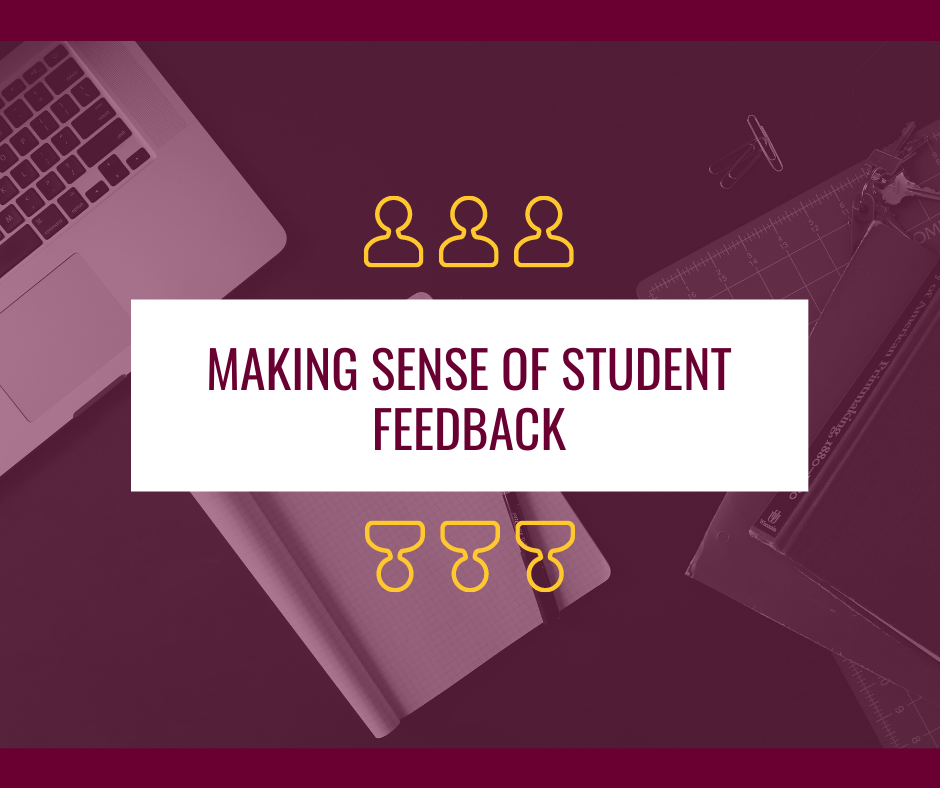Student surveys can be a valuable tool for educators to receive feedback from learners and adjust their teaching practices accordingly. If received early and implemented, formative learner feedback has been shown to increase summative student feedback scores by an average of .16 points (McGowan & Osguthorpe, 2011). Through student surveys, learners can comment on aspects of the course such as instruction, design, methods, and materials. While receiving positive scores and feedback can be affirming, undesirable scores or feedback can be challenging to receive. Thus, student surveys can also have sizable implications for job satisfaction and beyond (Watchel, 1998).
Carly Robinson, a researcher from Harvard Graduate School of Education, points out that learner feedback allows educators an opportunity to communicate value for learner experiences and input while modeling for learners how one might productively respond to feedback (as cited in Shafer, 2017). So, while we acknowledge that learners are not always equipped to assess instructional efficacy, we encourage educators to appreciate the value in learner feedback when considered within context.
When reviewing feedback, we recommend the following tips:
- Explore patterns, ratios, and mysteries within the contexts of sample size and response rate (Wicks, 2019);
- Acknowledge positive responses (and savor them!) along with opportunities for growth (Wicks, 2019 Buskist & Hogan, 2010);
- Consider the feasibility of short- and long-term adjustments, treating responses more like an experiment than an overhaul (Wicks, 2019);
- Throw out comments that are not useful or relate to things that can’t change (Buskist & Hogan, 2010);
- Explore perceptions, both implicit and explicit (e.g., “But, I already do that!” “Well, do they know you’re doing that?”) (Buskist & Hogan, 2010); and
- Categorize needs into one of three “buckets”: social, instructional, or operational. Prioritizing the “bucket” with the greatest need (Wicks, 2019).
If educators feel a strong emotional response from undesirable feedback, it may help to leverage some tips from Dialectical Behavior Therapy (DBT). DBT is comprised of two major components: radical acceptance and openness to change (Panos et al., 2014).
- Work Toward Radical Acceptance. An educator who is mindful attempts to be present in the moment, collecting data without judgment, which means one must be able to tolerate distress. We find that separating one’s sense of self-value from one’s performance as an educator can help reframe feedback as a response to a behavior instead of an attack on one’s person.
- Increase Openness to Change. Educators must be able to both recognize and manage the range of emotions one might feel in response to feedback. Additionally, one must be able to empathize with learners, communicating in ways that strengthen relationships while remaining assertive as is appropriate.
For more information about evaluating feedback, see our website or contact CIS for a consultation.
References
Buskist, C. & Hogan, J. (2010). She needs a haircut and a new pair of shoes: Handling those pesky course evaluations. Journal of Effective Teaching, 10(1), 51-56.
Ewing, P. (2012). Estimating the impact of relative expected grade on student evaluations of teachers. Economics of Education Review, 31(1), 141-154. https://doi.org/10.1016/j.econedurev.2011.10.002
McGowen, W. R. & Osgathorpe, R. T. (2011). Student and faculty perceptions of effects of midcourse evaluation. To Improve the Academy, 29, 160-172.
Panos, P. T., Jackson, J. W., Hasan, O., & Panos, A. (2013). Meta-analysis and systematic review assessing the efficacy of Dialectical Behavior Therapy (DBT). Research on Social Work Practice, 24(2). https://doi.org/10.1177/1049731513503047
Shafer, L. (2017). Making student feedback work: New advice on building a culture of feedback and making it meaningful for teachers. Usable Knowledge. Retrieved from http://www.gse.harvard.edu/news/uk/17/11/making-student-feedback-work
Watchel, H. K. (1998). Student evaluation of college teaching effectiveness: A brief review. Assessment & Evaluation in Higher Education, 23(2). https://doi.org/10.1080/0260293980230207
Wicks, J. M. (2019). How do SOSs affect our teaching…and how should they? [Workshop.] Slides retrieved from bit.ly/sosandteaching

